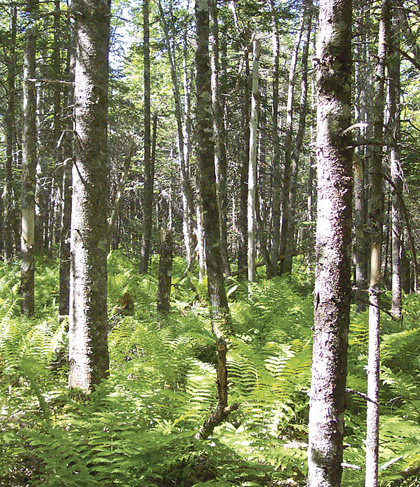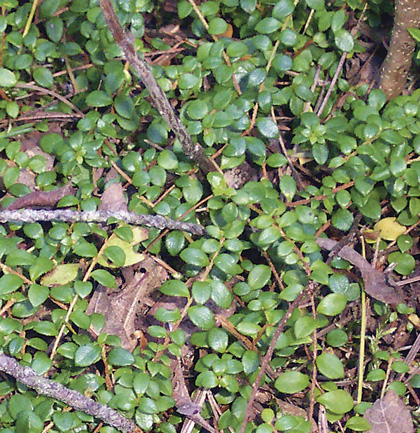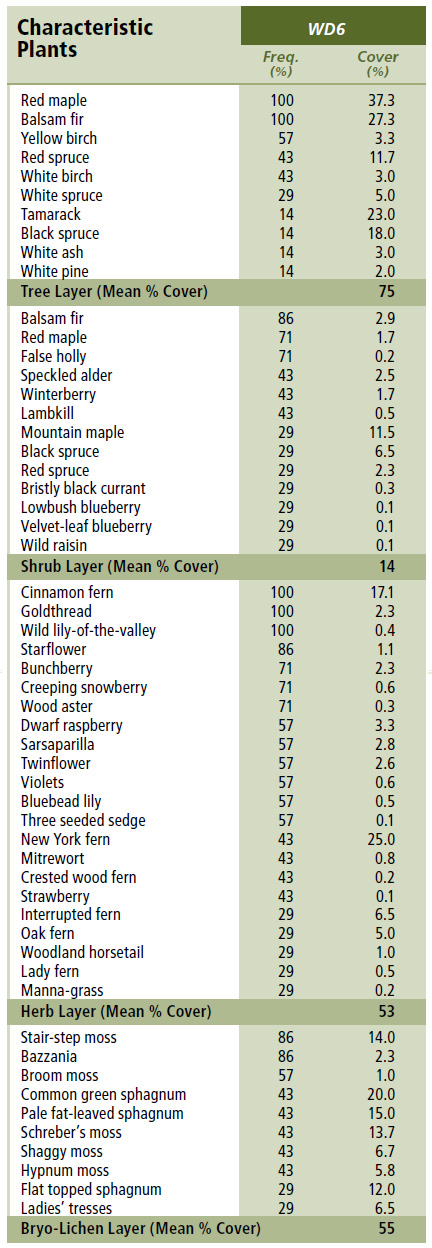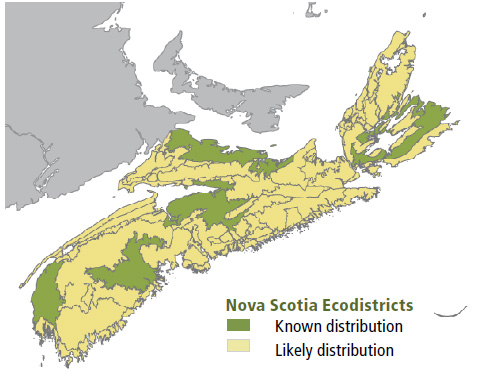
Forest Vegetation types - WD6
WD6 — Red maple – Balsam fir / Wood aster / Sphagnum
Acer rubrum – Abies balsamea / Aster acuminatus / Sphagnum spp.
 |
MacElmons Pond, Belmont, Colchester County |
Concept: Red maple - Balsam fir / Wood aster / Sphagnum is one of three wet mixedwood forests (WD6, WD7 and WD8) recognized in Nova Scotia, each largely distinguished by important differences in canopy composition and more minor differences in soil fertility and understory composition. This relatively common Vegetation Type (VT) is characterized by red maple and balsam fir co-dominance, moderate to high herbaceous cover and a well-developed bryophyte layer of sphagnum moss. It is usually found on poorly drained mineral soil, with low to medium nutrient availability.
Vegetation: Crown closure is moderate to high, although some stands support more widely spaced trees. The canopy is co-dominated by red maple and balsam fir; other tree species are infrequent and seldom abundant. The understory supports low to moderate levels of woody species but higher herbaceous cover. Characteristic vascular plants include false holly, cinnamon fern, creeping snowberry, wood aster and three seeded sedge. Bryophyte development is moderate, composed of sphagnum moss and lesser amounts of common upland species. Small patches of pale fat-leaved sphagnum, common green and/or flat topped sphagnum are sometimes present.
Environmental Setting: This is primarily a wet forest although occasionally it develops on moist sites. Soils are usually derived from glacial deposits, of varying texture, with at least some ground and/or surface water flow (organic deposits are also possible); nutrient availability is low to medium. The ecosystem occurs at low elevation in shallow depressions and on flats and cool gentle slopes with little microtopography. Rooting potential is strongly limited by high water level and sometimes compacted soils. Most occurrences are in the Western and Valley/Central Lowland ecoregions but outlying stands are scattered throughout the remainder of the mainland and lowland areas of Cape Breton. The VT is common on Prince Edward Island and across south and central New Brunswick.
Successional Dynamics: This ecosystem can be expressed at a variety of successional stages, but most stands are mid-successional. It is a type of edaphic climax (i.e. largely persisting because of limiting site conditions). Depending on the ecological context and local disturbance regime, WD6 could maintain itself or transition to WD2 (Red maple / Cinnamon fern / Sphagnum) or WC6 (Balsam fir / Cinnamon fern – Three seeded sedge / Sphagnum) after disturbance. Tree senescence, windthrow and intermediate-scaled harvest events like firewood and pulpwood cutting, are the primary disturbance agents, but harvesting and insect infestation can also occur at the stand-level. Between disturbance events, uneven-aged stands can develop through tree mortality originating with senescence.
Ecological Features: Mixedwood forests may support vertebrate and invertebrate species associated with both coniferous and deciduous wetlands. Wildlife which utilize either hardwood or softwood structures will often seek small clumps of target canopy trees within broader matrices of dissimilar species. The Red maple – Balsam fir / Wood aster / Sphagnum VT is a moderately productive mixedwood forest, with a well-developed canopy and often dense understory strata. Small pools or narrow channels of standing or very slowly moving water are typical, and may provide important habitat for amphibians and other wildlife. This small patch ecosystem supports similar biodiversity values as WD2, but occurs in more sheltered areas with lower peat accumulations. These characteristics may influence the VT’s ecology and contributions to local landscape structure and function. Observations of alder-leafed buckthorn and black ash were found in available plot data.
 |
| Creeping snowberry |
Distinguishing Features: Red maple and balsam fir in the overstory layer define this wet mixedwood forest. Characteristic plants include false holly, cinnamon fern, creeping snowberry, wood aster and three seeded sedge. Common green sphagnum and pale fat-leaved sphagnum are common.
| Slope Position: | Level8 Lower1 Toe1 |
Surface Stoniness: |
(Non - Slightly)10 |
Bedrock Outcrop: |
(Non-rocky)10 |
Elevation Range: |
5 - 124m |
Slope Gradient: |
Level9 Gentle1 |
Aspect: |
North1 West1 None8 |
Exposure: |
Moderate9 Mod. Sheltered1 |
Microtopography: |
Level7 Slightly3 |
Drainage: |
Poor4 Very poor4 Imperfect2 |
Soil Type: |
ST76 ST41 ST91 ST101 ST141 |
Parent Material: |
Glacial till7 Organic1 Glaciofluvial1 nd1 |
Rooting Depth (cm): |
(<30)9 (30-45)1 |
Duff Thickness (cm): |
(0-5)1 (6-10)1 (11-20)6 (21-40)1 (>40)1 |

